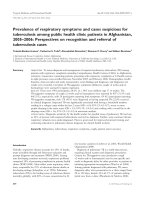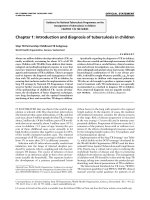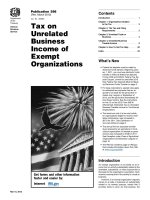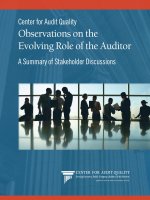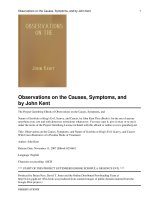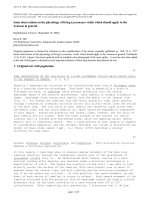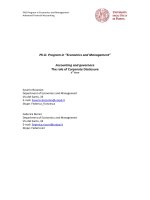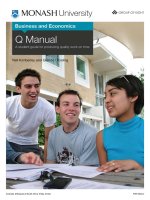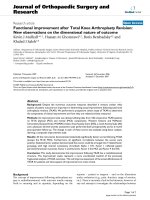Center for Audit Quality Observations on the Evolving Role of the Auditor: A Summary of Stakeholder Discussions doc
Bạn đang xem bản rút gọn của tài liệu. Xem và tải ngay bản đầy đủ của tài liệu tại đây (3.53 MB, 20 trang )
Center for Audit Quality
Observations on the
Evolving Role of the Auditor
A Summary of Stakeholder Discussions
The role of the public company auditor and whether it should evolve is
being examined in the United States and around the globe by regulators,
standard-setters and others.
The issues are complex and difficult to resolve in isolation. The “what, whys, and hows”
related to changing the role of the auditor has to be considered within the context of the
overall financial reporting system, including the important roles of the audit committee
(which oversees a company’s financial reporting and the auditor) and company management
(which has primary responsibility for financial reporting). Regulatory frameworks and over-
sight schemes for financial reporting and public company auditors are also key elements of
that context.
The Center for Audit Quality (CAQ) and the public company auditing profession support
responsible changes to the auditor’s reporting model and the role of the auditor. Accordingly,
the CAQ is facilitating robust discussion on the issue by all stakeholders—including those who
contribute to the financial reporting process and those who use financial reports.
Between May and July 2011, the CAQ sponsored four roundtable discussions in several
cities to explore how the auditor’s role might change and evolve to improve financial reporting
beyond the boundaries of the financial statements and internal control over financial reporting.
What follows is a summary of the key observations made during candid sessions attended
by investors, CEOs/CFOs, auditors, academics, attorneys, former regulators, and other
interested parties.
The CAQ plans to continue this dialogue with stakeholders in order to develop actionable
recommendations on changes to the role of the auditor consistent with audit quality and
investor protection.
Sincerely,
Cindy Fornelli
Executive Director
CENTER FOR AUDIT QUALITY OBSERVATIONS ON THE EVOLVING ROLE OF THE AUDITOR—A SUMMARY OF STAKEHOLDER DISCUSSIONS
1
Introduction
Over the years, the role of the public company auditor has been examined periodically to assess its rel-
evancy in light of changing market practices and investor information needs. The topic was raised most
recently following the financial crisis due to concerns about a perceived “disconnect” between what was
reported in some companies’ annual reports and the companies’ subsequent failure or need for liquidity.
Some suggest that this “disconnect” has called into question the relevance and value of the audit, which
has led to several initiatives to explore areas for additional transparency into the audit process as well as
areas where auditors could better serve the needs of investors.
Both the Public Company Accounting Oversight Board (PCAOB) and the International Auditing and As-
surance Standards Board (IAASB) have launched initiatives to reexamine the auditor’s report, and as part
of its effort, the PCAOB held a series of outreach meetings to explore possible alternatives to the current
reporting model.
1
During those meetings, the Center for Audit Quality (CAQ), established in 2007 to serve
investors and the capital markets by advancing audit quality across the public accounting profession,
shared the views of the profession on areas where improvements could be made to the auditor’s report.
As stated in the CAQ’s comment letter to the PCAOB dated June 28, 2011, the profession recognizes that
change is needed and is prepared to embrace responsible calls for change. The CAQ also stated that it
is necessary to take a holistic
approach in which all stake-
holders agree on a way
forward that will best serve
investors if such change is to
be meaningful.
To explore areas where
change may be appropriate,
the CAQ formed a task force
on the role of the auditor and
moved to convene investors
and other financial reporting
stakeholders to examine the
role of the auditor and the
value of the audit.
1
On June 21 the PCAOB issued a concept release on potential revisions to the auditor’s reporting model. Topics raised for
public comment include what additional information auditors might communicate or report to investors concerning the audit
and its findings and whether the scope of auditor attestation or assurance should expand beyond the audits of the financial
statements and internal control over financial reporting. The IAASB, the UK Financial Reporting Council, and the European
Commission are exploring similar issues.
2
During the summer of 2011, the CAQ held roundtable discussions on the role of the auditor in
Dallas, New York City, San Francisco and Chicago. Each roundtable was attended by approximately
20 participants reflecting the full range of financial reporting stakeholders—CEOs, CFOs, board and
audit committee members, investors, auditors, former regulators, attorneys and academics.
At each roundtable, the profession expressed a willingness to listen and explore changes to its role.
Participants were asked what information investors need that they currently do not receive and who in
the financial reporting chain is best suited to provide that information. They explored whether the audi-
tor’s role might change and evolve to improve financial reporting beyond the boundaries of the audit of
the financial statements and internal control over financial reporting. In this regard, although the round-
tables were designed to discuss the evolving role of the auditor, it often was difficult for participants to
move beyond dissatisfaction with the current state of financial reporting, and in particular, the fact that
annual reports are in a state of “disclosure overload” resulting from the expanding complexity of Gener-
ally Accepted Accounting Principles (GAAP), as well as compliance and liability concerns on the part
of preparers and counsel. It quickly became clear that the auditor’s role had to be considered within the
context of the broader corporate financial reporting framework, including the roles of management (pre-
parers), the audit committee, investors, regulators and standard setters.
Below are an overview of the roundtable discussions and a summary of key observations, i.e., observations
made during at least two roundtables and on which there was substantial agreement. The observations
are arranged by those that apply mainly to the corporate reporting framework (preparers, audit com-
mittees and regulators/standard setters) and those that apply mainly to the external auditor’s role in the
reporting process. While a number of observations received wide agreement, the setting did not lend
itself to obtaining all the details necessary to form specific recommendations. This report concludes with
identification of the CAQ’s short and longer-term next steps to further pursue observations regarding the
role of the auditor. Appendix A to this report contains a more detailed summary of observations from
the roundtable discussions; Appendix B contains a list of participants by roundtable. This summary
report was provided to the roundta-
ble participants to assure that it fairly
describes the observations made dur-
ing the sessions.
INTRODUCTION
CENTER FOR AUDIT QUALITY OBSERVATIONS ON THE EVOLVING ROLE OF THE AUDITOR—A SUMMARY OF STAKEHOLDER DISCUSSIONS
3
Overview
The starting point for each roundtable discussion was to ask what information investors need that they
currently do not receive and who in the financial reporting chain is best suited to provide that informa-
tion. Follow-up questions included what changes are necessary to meet investors’ information needs and
how they should be implemented. Participants consistently
expressed dissatisfaction with current compliance-oriented
financial reports and questioned whether they appropriately
serve their intended purpose of communicating to investors.
Moreover, participants commented that changes to the role
of the auditor without corresponding action to improve weak-
nesses identified in the corporate reporting framework may not
sufficiently respond to investor financial reporting concerns.
Participants also were asked whether the current audit provides value and if there is more information
auditors might share with investors and others about the audits of the financial statements and internal
control over financial reporting. Participants agreed that the audit does have value in providing rea-
sonable assurance whether the financial statements
comply with GAAP and is viewed as a necessary
“prescreen” or baseline by investors. They posited
that auditors should continue to provide a binary
audit report on the financial statements, noting that
any changes to the role of the auditor should sup-
plement the current audit process given its value.
Several participants thought auditors might share
more about the areas of highest risk in the financial
statements although others pointed out the danger
in such comments of investor misunderstanding
and overreaction.
When asked what additional services public com-
pany auditors might provide beyond their current
responsibilities for the audits of the financial state-
ments and internal control over financial reporting,
participants identified a number of disclosures that could be improved by management and/or might
be appropriate for auditor association. The disclosures most commonly identified related to financial
information contained in Management’s Discussion and Analysis (MD&A); the company’s process for
assessing risk and developing financial assumptions and estimates; the company’s critical judgments and
accounting estimates; and the risk factors disclosure in the annual report.
The auditor’s traditional
pass-fail opinion is
a necessary “baseline”
4
However, in discussing the range of information in the annual report—financial and non-financial—
that auditors might attest to, or otherwise be associated with, preparers, audit committee and attorney
participants consistently cautioned that some areas may not be “auditable,” or that auditors may not
have sufficient access to information and/or the necessary skills or experience to form an opinion (e.g.,
business model, certain types of forward-looking information). They also warned against exacerbating
information overload.
Participants strongly resisted the notion of auditors publicly providing their “impressions” or views
regarding the quality of a company’s accounting policies and practices. Participants believed that the
auditor’s established role of attesting on information provided by management is appropriate and should
not change.
Participants agreed that investors/markets act on current information, including financial information and
other communications provided by management throughout the year, notably the annual and quarterly
earnings releases. A significant number of participants thought these disclosures may have more signifi-
cant relevance to investing decisions than the annual report, or the related auditor’s opinion. Whether
some level of auditor assurance would add further value to certain communications from management to
investors was an area all participants thought should be explored further.
Participants repeatedly acknowledged that any changes to the role of the auditor must be effected through
a sanctioned framework to assure that expectations are clearly defined for auditors. There also was con-
cern about unintended consequences, in particular how changes to the role of the auditor could impact
the role of management and audit committees as the providers of information, specifically with respect to
their primary responsibility for the financial statements and internal control over financial reporting.
Preparers, audit committee members and attorneys also worried about increases in the cost of compli-
ance and heightened liability exposure for both management and auditors.
OVERWIEV
CENTER FOR AUDIT QUALITY OBSERVATIONS ON THE EVOLVING ROLE OF THE AUDITOR—A SUMMARY OF STAKEHOLDER DISCUSSIONS
5
Key Observations
CORPORATE REPORTING FRAMEWORK
• Allparticipants,ledbyinvestorsandpreparers,statedthatannualreportsareinastateof“disclo-
sure overload” resulting from the expanding complexity of GAAP, as well as compliance and liability
concerns on the part of preparers and counsel. There was a clear call from investors and preparers
for elimination of redundant material in annual reports through better coordination of disclosures
related to legal information, management analysis, audited information, and, importantly a prioriti-
zation of, risk factors. Former regulators suggested that there is more that regulators and standard
setters could do under current regulations (e.g., the safe harbor afforded under MD&A regulations)
to encourage financial reporting that better suits the needs of investors, particularly their need for
qualitative and forward-looking information.
• Participantsalsocommentedthatchangestothecorporatereportingframeworkandauditor’sre-
porting model will require establishment of a framework that provides sufficient clarity of roles,
definitions of terms, metrics, etc.
• Auditcommitteemembersandpreparersrecommendedthatthefullrangeofstakeholdersdevelop
a shared vision on the appropriate content of annual reports for today’s investor needs without be-
ing hindered by the current reporting requirements or legal/liability risks. They further suggested
that the best chance of effecting meaningful improvements to financial reporting is through a “pilot
program” authorized by regulators/standard setters, comprised of investors, preparers, auditors, and
audit committee members charged with developing examples of streamlined annual reports and fi-
nancial statements that focus on “what matters” to investors within an appropriate safe harbor.
• Preparersandauditcommitteemembersstatedthatauditorscurrentlyprovidesignicantvaluable
input on the accounting policies selected by management. Audit committee members stated that they
have frequent substantive discussions with auditors on a range of accounting policies and issues, and
some suggested that the audit committee might provide an expanded report on its activities —in-
cluding the frequency of communications and range of topics discussed with the auditors—to increase
confidence that audit committees are fulfilling their responsibilities. Some participants suggested that
auditors might provide some level of assurance around such a report. In addition, audit committee
members thought that an expanded audit committee report demonstrating robust interaction with,
and oversight of, auditors also would raise the performance bar for audit committees in general. Par-
ticipants thought that this is a matter that audit committees should pursue, with input from investors
and auditors, as well as regulators who may have to provide a regulatory and reporting framework.
• However,participantsgenerallydidnotbelievethatauditcommitteesshouldsharethecontent of
the auditor’s written/oral communications with investors because investors would not have the ap-
6
propriate context derived through the dialogue between the audit committee and the auditor. Audit
committee members and investors thought such a practice would undermine the audit committee’s
ability to oversee financial reporting as communication may become more limited given the possibil-
ity of matters being misunderstood or taken out of context; although the concept of sharing certain
auditor communications was endorsed by some without general agreement on specific areas.
ROLE OF THE AUDITOR
• Investorsandotherparticipantsuniformlyagreedthattheauditisvaluableandthecurrent“pass-fail”
report should be retained. Investors and a rating agency representative stated that a “clean” opinion
on the financial statements and internal control over financial reporting provides investors with some
“comfort” as it relates to other financial information provided by management. However, investors
noted that financial statements are often used only as a “prescreen” because investors and analysts
today rely on a range of quantitative information and financial models to make investment decisions,
much of which is obtained from more current communications from management to investors out-
side of the historical annual report.
• Withrespecttothenancialstatementaudit,severalin-
vestors thought that auditors could “convey more” about
the highest risk areas of financial statements, which
might be done through, for example, an emphasis of a
matter paragraph in the audit report, to add credibility to
the report (although preparers and attorneys commented
that the cost of additional work and legal risks of provid-
ing this information might outweigh any benefit).
• Participantsstronglybelievedthat the auditor’sroleshouldbelimitedtoattestingto information
provided by management and that auditors should not provide their own “impressions” or views
regarding the quality of a company’s accounting policies and practices. Audit committee members,
preparers, attorneys and auditors thought that such analysis would “compete” with management’s
disclosures and ultimately shift the responsibility for accounting and disclosure away from manage-
ment to the auditor. These “dueling” disclosures could also have the potential to confuse investors.
Moreover, even if the disclosures were consistent the result would be additional redundancies, that
would be time consuming and costly for the auditor to prepare due to the number of reviews that
would be necessary prior to issuance.
• Participantsthoughtinvestorswouldbenetfromauditorassociationwithcertainareasofthean-
nual report outside of the audited financial statements to provide investors additional assurance on
matters they view as most important to their understanding of a company’s financial performance
and future prospects. Several investors suggested that they would appreciate some level of assurance
around certain other financial and non-financial information used to analyze a company (e.g., disclo-
sures in press releases, key performance indicators, and non-GAAP measures) and whether risks are
appropriately described. However, given the limited discussion time, participants were not able to
identify specific types of information or the levels of assurance that would be appropriate. Also, some
KEY OBSERVATIONS
Investors rely on a
range of company
communications, much
of it outside of the
financial statements
CENTER FOR AUDIT QUALITY OBSERVATIONS ON THE EVOLVING ROLE OF THE AUDITOR—A SUMMARY OF STAKEHOLDER DISCUSSIONS
7
participants thought that less sophisticated investors may not be aware that auditors currently pro-
vide some value by reading other information provided outside of the audited financial statements
for consistency with the audited financial statements.
• Participants acknowledged that some information may not be “auditable” or would require sub-
stantial additional work before the auditor could issue some type of report (i.e., areas not currently
examined as part of the audits of the financial statements and internal control over financial report-
ing). Also, audit committee chairs, former CEOs, attorneys, academics and investors thought that
at present auditors may not have access to the appropriate information, or lack the necessary skill-
set or experience to form an opinion on such information (e.g., business model, certain types of
forward-looking information). Preparers and board members thought that analysts already fill this
role. Academics noted that auditor review of these disclosures is not covered by current auditing
standards, not tested in the CPA examination, and is not taught in universities.
• Otherconsiderationsraisedincludethecost-
benefits of additional auditor assurance, the
impact on management’s reporting practices,
and liability concerns. Also, it was noted by
preparers and analysts that many terms used
by management are not used or defined con-
sistently (e.g., research and development,
general and administrative expense and cus-
tomer information), which adds another layer
of complexity for auditors and investors.
• Therewasstrongendorsementofauditoras-
sociation with earnings releases, which are of
keen interest to investors, although partici-
pants did not specify the level of assurance that might be most helpful. Investors also expressed interest
in auditor association with forward-looking information provided by management, while CEOs and
others saw many practical obstacles to this suggestion. Auditor association with this information would
require regulatory action or guidance to assure consistency of approach, as well as a need to consider
safe harbors or other litigation protection. There was some agreement that auditors should be required to
attest to financial information in press releases or other written reports (e.g., quarterly or current reports
filed with the Securities and Exchange Commission [SEC]), although participants agreed that it would
not be practical for auditors to review or provide some level of assurance on the plethora of meetings,
calls and other communications that management has with investors and analysts. They also noted that
auditor association would impact the timeliness of management’s press releases or written reports.
• Preparersandboardmemberssuggestedthatifauditorsareaskedtodomorewithrespecttodis-
closures outside of the financial statements, then regulators should identify whether there are areas
within the auditor’s current responsibilities that might be scaled back (within a sanctioned frame-
work) so that the new work would be “cost neutral” for public companies. The intent would be to
focus auditor efforts on areas that provide the most value to investors.
8
Conclusion and Next Steps
The CAQ plans to continue its dialogue with stakeholders here and abroad to explore ways to evolve the
role of the auditor to meet the needs of investors in the near and longer term. In the near term, the CAQ
and its member firms have developed model reports for the PCAOB and other stakeholders to consider
that respond to calls for additional communications by the auditor. These enhanced communications
should raise the level of understanding about a particular audit‘s focus and quality and, in turn, the qual-
ity of management’s financial reporting.
However, if the profession is to
effect more profound change, it
is of paramount importance to
explore the roundtable obser-
vations more deeply as changes
could have profound impacts,
including unintended conse-
quences. Alternatives must be
clearly defined, tested and fully
vetted across all financial re-
porting stakeholders to see if
they will engender the desired
results in the most efficient and
effective way.
The CAQ and the profession
heard investors call for stream-
lined reporting with improved
content to reflect what matters to investors today in analyzing a company. We also heard that audit com-
mittees might play an expanded role in corporate reporting. The CAQ and the profession are willing to
take a leadership role in a pilot program with other stakeholders to develop a shared vision on corporate
reporting and the role auditors should play.
In adition, the CAQ is continuing to work with the full range of stakeholders to define actionable recom-
mendations that specifically pertain to the role of the auditor. This work will center on:
(1) What specific areas of the annual report (outside of the financial statements) would benefit from
auditor association?
CENTER FOR AUDIT QUALITY OBSERVATIONS ON THE EVOLVING ROLE OF THE AUDITOR—A SUMMARY OF STAKEHOLDER DISCUSSIONS
9
(2) For each area:
• Whatlevelofassuranceshouldbeprovidedandwhat is the appropriateformofauditor
communication?
• Wouldauditorassociationrequiresignicantadditionalprocedures(separatefromdraftingthe
auditor’s communication)? What would be the additional cost of these procedures? Would the
benefits outweigh the costs?
• Whatwouldtheimpactbeonmanagement’sreportingpractices?
• Whatwouldtheimpactbeoncommunicationbetweentheauditorandmanagement?Theauditor
and the audit committee?
• Whatwouldtheimpactbeonmanagement’sandauditors’respectiveliabilities?
(3) Should auditors provide some level of assurance on earnings releases? What level of assurance is
sought? Would auditor assurance significantly affect the timing of issuance? Would regulatory action
be required to enact such change?
(4) Are there other types of financial or non-financial reports issued by management that auditors should
report on (e.g., 10-Qs, 8-Ks, press releases)? If so, what parts?
• Whatwouldbethecost,timingandotherpracticalconsiderations?
(5) If some changes to the role of the auditor involve a “culture change,” how will auditors obtain the
necessary skills and experience to perform this additional work? How long will it take for universities
to expand the accounting and auditing curriculum to address the required skills?
This additional work will be shared with policymakers and other stakeholders to inform change and
encourage consistency of approach across jurisdictions.
10
APPENDIX A
Summary of Observations
CORPORATE REPORTING – CURRENT STATE
• Thecompanyhasfundamentalresponsibilityfordisclosingnancialinformation,includingforward-lookingin-
formation, and this should not change (all participants).
• Annualreportsareinastateof“disclosureoverload”andaretoocomplextobeusefultonancialstatementusers.
Examples cited include redundancy in information disclosed between the financial statements and MD&A and a
risk factors discussion that contains “anything and everything” (all participants).
• Whilecompaniescouldprovidebetterdisclosurewithmoremeaningfulinformationandlessredundancy,annual
reports are a “law-driven document” due to regulatory requirements and legal precedent (analysts, attorneys and
preparers).
• Investorsincreasinglyseekforward-lookingandnon-nancialinformationthatisqualitativeinnatureresultingin
the increased importance of MD&A (investors, board members, preparers, former regulators). However, MD&A
has become “boilerplate” (all participants) resulting from:
t
Lack of adherence to (and enforcement of) SEC regulations and interpretive guidance for MD&A disclosure
(attorneys and former regulators).
t
Management is not taking advantage of the safe harbor afforded by SEC regulations for forward-looking in-
formation in MD&A (attorneys and former regulators).
t
Less robust disclosure requirements in foreign jurisdictions create competitive concerns about MD&A and
risk disclosures (investors, preparers).
• Bythetimetheannualreportisissued,theinformationcontainedistoodatedtodriveinvestmentdecisions;itis
most often used as a baseline, supplemented with additional analysis based on more current information such as
quarterly reports and press releases (investors, analysts, preparers, academics).
ROLE OF THE AUDITOR – CURRENT STATE
• Theauditisvaluableandshouldnotbeunderestimated(allparticipants).
• Althoughdated,a“clean”opiniononthenancialstatementsandinternalcontrolsovernancialreportingpro-
vides investors with some “comfort” as to the other financial information provided by management (investors and
analysts).
• Auditorscurrentlyevaluatecertain“auditable”forward-lookinginformationunderlyingnancialstatementesti-
mates (e.g., level 3 fair value measurements, useful lives, salvage value, assumptions underlying post employment
benefit obligations) (auditors and former regulators).
• Auditingstandardsrequiretheauditortoreadtheannualreportandidentifymaterialinconsistenciesbetweenun-
audited (e.g., MD&A) and audited (financial statement) information. Additionally, many auditors review earnings
releases for consistency with the information generated as a part of the in-progress audit. These procedures provide
value, however, many users are unaware that these procedures are performed (audit committee and preparers).
CENTER FOR AUDIT QUALITY OBSERVATIONS ON THE EVOLVING ROLE OF THE AUDITOR—A SUMMARY OF STAKEHOLDER DISCUSSIONS
11
• Itisnotpracticableforauditorstobeinvolvedinallofmanagement’smeetingsandconferencecallswithinvestors,
analysts and others participants. Additionally, auditor involvement could reduce the substance and timeliness of
information provided by management (investors and preparers).
• Auditorsprovidesignicantvaluetotheauditcommitteeandmanagementthroughtheiraudittestsandobserva-
tions relative to accounting principles, estimates, assumptions, control environment, tone at the top, fraud risk,
etc. (preparers and audit committee members).
CORPORATE REPORTING – AREAS FOR FURTHER CONSIDERATION
GENERAL
• Annual reports must be streamlined to focus on “what’s important” to investors, particularly with respect to
MD&A and management’s discussion of risk factors (all participants).
• Thereisacriticalneedtodevelopasharedvisionformeaningfuldisclosuresintheannualreportwiththein-
formation needs of investors in mind without being hindered by current reporting requirements and the legal
environment. A “pilot program” convening all stakeholders could develop examples of annual reports and finan-
cial statements that would better inform investors on “what matters.” The appropriate degree of assurance also
would be considered. Such an effort would likely require some sort of safe harbor due to the current legal and
regulatory environment (all participants).
PREPARERS
• Annualreportsshouldbestreamlinedtoprovidemorerelevantinformationandeliminateredundanciesbetween
disclosures (investors and attorneys).
• MD&A should provide more forward-looking information, key performance indicators and other qualitative
information regarding the value drivers of the company, which are increasingly important to investors (investors
and attorneys).
• TheMD&Asafeharborforforward-lookinginformationalreadyprovidesameansforbetterdisclosure(investors,
board members, former regulators and attorneys).
• Theriskfactordiscussionintheannualreportshouldbedisclosedina“clean,concise”mannerwithafocuson
the information needs of investors as opposed to legal considerations. It was suggested that most investors would
be satisfied if management provided further information about: 1) the tone at the top and how it gets communi-
cated throughout the organization; 2) the macro risks for a company’s sector; 3) the micro risks for a company’s
particular business; and 4) the programs or strategies management has in place to manage such risks (investors,
board members and preparers).
BOARD/AUDIT COMMITTEE MEMBERS
• Theauditcommitteeshouldprovideinvestorswithanexpandedreportontheiractivitiesincludingoversightof
the auditor (i.e., frequency and range of interaction with the auditor) in order to promote investor confidence in
the role/responsibilities of the audit committee and to raise the performance bar for audit committees (audit com-
mittee member).
• Theauditcommitteeshouldnotsharewithinvestorsthecontentoftherequiredauditor’scommunicationstothe
audit committee because investors may misinterpret such information without the context of the dialogue between
the audit committee and auditor (audit committee members, preparers, auditors).
12
• Most participants preferred that disclosure of auditor communications to the audit committee, if ultimately
required, be made by the audit committee rather than the auditor with some level of auditor association for ac-
curacy. However, some participants feared that such disclosure would destroy the communications between the
audit committee and auditors to the detriment of investors (audit committee members).
REGULATORS/STANDARD SETTERS
• Changestothecorporatereportingframeworkandtheroleoftheauditorcannotbeaccomplishedwithoutthe
establishment of a framework that provides sufficient clarity of roles, definitions of terms, metrics, etc. (preparers
and auditors).
• Thereisaneedfor a global corporatereportingframeworkthat mitigates competitive disadvantages forU.S.
companies who must provide more comprehensive disclosure (i.e., strategy and risk) than their international
competitors (preparers, investor).
• Withrespecttoincreasingthescopeofauditorresponsibilities,itisimportantforstandardsetterstoconsider
whether:
t
It is reasonably possible to provide assurance on particular information. Where it is, the appropriate level
of assurance should be determined (academics, attorneys, preparers, audit committee members, CEOs and
auditors).
t
Current auditing standards exist or are necessary to evaluate such information and whether auditors have the
requisite training to “audit” such areas (academics, attorneys, preparers, audit committee members, auditors).
t
Auditor responsibilities in areas of lesser value to investors should be scaled back (within a sanctioned frame-
work) so that any additional work would be “cost neutral” for public companies (preparers, audit committee
members, CEOs).
ACADEMIA
• Shouldanincreaseinthescopeofauditorresponsibilitiesbedeemedappropriate,respectivemodicationsmay
be necessary to the CPA examination as well as college curricula to ensure auditors are appropriately trained in
these areas (i.e., specifically in regard to evaluating information outside of the financial statements) (auditors,
academics, board members and audit committee members).
ROLE OF THE AUDITOR – AREAS FOR FURTHER CONSIDERATION
INFORMATION ABOUT THE AUDIT
• Theauditor’straditionalroleofattestingtoinformationprovidedbymanagementshouldnotchange(all
participants).
• Auditorscouldidentifyforinvestorstheareasofhighestriskinthenancialstatementsandhowtheauditor
responded to those risks through, for example an emphasis of a matter paragraph in the audit report, to add cred-
ibility to the report. Some participants acknowledged that the benefits of such information may be outweighed by
the: 1) legal risks resulting in such disclosures becoming “boilerplate” over time; and 2) the cost of the additional
work associated with providing this additional communication (investors, attorneys, preparers). Others pointed
out the danger of investor misunderstanding and overreaction.
• Auditorscouldprovidesomelevelofassuranceonanexpandedreportfromtheauditcommitteetoinvestors
describing the frequency and range of interaction with the auditor.
APPENDIX A
CENTER FOR AUDIT QUALITY OBSERVATIONS ON THE EVOLVING ROLE OF THE AUDITOR—A SUMMARY OF STAKEHOLDER DISCUSSIONS
13
• Auditorsshouldnotprovidetheirowndiscussionandanalysis(AD&A)orotherqualitativeanalysisofacompany
as it would be highly subjective, could result in “dueling disclosures” that compete with management’s disclosures
and/or disclosure redundancy contributing to further “disclosure overload,” may shift the responsibility for deter-
mining financial statement disclosures from management to the auditor, and could be time-consuming and costly
to implement due to the number of reviews necessary (all participants).
INFORMATION OUTSIDE OF THE FINANCIAL STATEMENTS – RISK FACTORS
• Theauditorcouldprovidesomelevelofassuranceonrisks(e.g.,liquidityrisk,etc.)prioritizedbymanagement
in its risk factor discussion. Some participants noted that the auditor’s involvement should be limited to assessing
financial risks as opposed to nonfinancial risks (e.g., human capital, information technology, etc.). Additionally,
several participants noted that the auditor has a “limited field of view” and cannot be adequately informed on all
aspects of the business to make judgments on whether risk factor disclosures are accurate and complete (prepar-
ers, board member and attorney).
INFORMATION OUTSIDE OF THE FINANCIAL STATEMENTS – MD&A
• Auditors could providesome level of assurance on MD&A
related to:
t
Completeness and accuracy of information disclosed in
MD&A (preparer).
t
The process by which management develops accounting
estimates and underlying assumptions, assesses related
risks, and the accuracy of such information disclosed in the
MD&A (investors, preparers, audit committees).
t
Non-financial information (e.g., human capital, informa-
tion technology) disclosed in MD&A. Others thought this
would be outside the auditor’s area of expertise (investors,
preparers, academics).
• ExpandingauditorassociationtopartsofMD&Aislikelytopromotemorecompletedisclosuresbymanagement.
It also was acknowledged the additional work would add cost, because the auditor is currently required to only
read other information provided outside of the audited financial statements (e.g., critical accounting estimates)
for consistency with the audited financial statements (preparers and attorneys).
• Whilepreparersbelieveadditionalworkshouldbe“costneutral,”duetoalreadyhighcompliancecosts,there
were no specific recommendations on where other audit procedures might be streamlined.
INFORMATION OUTSIDE OF THE ANNUAL REPORT – PRESS RELEASES, QUARTERLY REPORTS
• Managementcontinuouslyprovidesinformationtoinvestorsthroughouttheyear.Auditorscouldprovidesome
level of assurance on certain information included in 10-Qs, 8-Ks and press releases (preparers, audit committee
members, investors) although CEOs and others noted practical obstacles to this suggestion.
• Whileinvestorsunderstandthatmanagement’sforward-lookinginformationwillbeinherentlyinaccurate,they
would have more confidence in management’s disclosures if the auditor commented on the process used to de-
velop the information (investors and preparers).
• Itisnotpracticableforauditorstobeinvolvedinallofmanagement’smeetingsandconferencecallswithinvestors,
analysts and other stakeholders throughout the year. Additionally, auditor involvement with these conversations
could reduce the amount and timeliness of information discussed by management (investors and preparers).
Could auditors provide
assurance around
other company
communications, such as
press releases and key
performance indicators?
14
Appendix B
Participants in CAQ Role of the Auditor
Roundtable Discussions
DALLAS
Discussion Moderator:
Clive Crook, Senior Editor, The Atlantic
John Bachmann, Chairman of Audit Committee, AMR Corporation, and Senior Partner, Edward Jones
Jana Bell, Chief Financial Officer, EF Johnson Technologies, Inc.
Mike Boone, Co-Founder, Haynes and Boone
Daniel Cancelmi, Controller, Tenet Healthcare Corporate
Michael Dastugue, Executive Vice President and Chief Financial Officer, JCPenney Corporation, Inc.
Cindy Fornelli, Executive Director, Center for Audit Quality
Mike Hewatt, Audit Committee Chairman, DR Horton
Thomas Hughes, Partner, Fulbright & Jaworksi LLP
Terry Iannaconi, Partner in Charge, Department of Professional Practice Knowledge Sharing, KPMG LLP
Stephanie Jones, Portfolio Manager, Smith Group Asset Management
William Kinney, Jr., Ph.D., Chair in Business and PricewaterhouseCoopers Fellow in Auditing, University of
Texas, Austin
Tom Kiraly, Chief Financial Officer, Concentra
Bill Knibloe, Partner, Audit and Financial Advisory, Crowe Horwath LLP
Constantine Konstans, Ph.D., Professor of Accounting and Corporate Governance, University of Texas at Dallas
Craig Lentzsch, Chairman, Audit Committee, Dynamex, Inc.
Andy McMaster, Vice Chairman, Deloitte LLP
Bob Moritz, Chairman and Senior Partner, PricewaterhouseCoopers LLP
Biggs Porter, Chief Financial Officer, Tenet Healthcare Corporate
Gary Walsh, Principal, Portfolio Manager/Analyst, Luther King Capital Management
NEW YORK
Discussion Moderator:
Clive Crook, Senior Editor, The Atlantic
Neri Bukspan, Executive Managing Director and Chief Quality Officer, Standard & Poor’s
CENTER FOR AUDIT QUALITY OBSERVATIONS ON THE EVOLVING ROLE OF THE AUDITOR—A SUMMARY OF STAKEHOLDER DISCUSSIONS
15
J. Michael Cook, Board Member, Comcast and International Flavors and Fragrances, and retired Chairman and Chief
Executive Officer, Deloitte & Touche LLP
Cindy Fornelli, Executive Director, Center for Audit Quality
Joseph Giordano, Chief Financial Officer and Treasurer, Drew Industries
Harvey Goldschmid, Dwight Professor of Law, Columbia University, Senior Counsel, Weil, Gotshal & Manges, and
Governing Board Member, Center for Audit Quality
Dan Goldwasser, Partner, Vedder Price P.C.
Wayne Kolins, Partner and National Director of Assurance, BDO USA LLP
Douglas Maine, Limited Partner and Senior Advisor, Brown Brothers Harriman, and Audit Committee Chairman,
Rockwood Holdings, Inc., Alliant Techsystems and BroadSoft
Bob Moritz, Chairman and Senior Partner, PricewaterhouseCoopers LLP
Devin Murphy, Vice Chairman, Investment Banking, Morgan Stanley
Joseph Perry, Firm-Wide Partner in Charge of Tax and Business Services, Marcum LLP, and Audit Committee
Member, Dime Community Bancshares
Barbara Porco, Ph.D., Director of Financial and Budgetary Development, Office of the Provost, Fordham University
Robert Rozek, Chief Financial Officer and Executive Vice President, Cushman & Wakefield
Sam Ranzilla, National Managing Partner, Audit Quality and Professional Practice, KPMG LLP
Stephen Ryan, Ph.D., Professor of Accounting and KPMG Faculty Fellow, Stern School of Business, New York
University
Larry Salva, Senior Vice President, Chief Accounting Officer and Controller, Comcast
E. Lyndon Tefft, Executive Vice President and Chief Financial Officer, Commonfund
Roman Weil, Ph.D., Director, MainStay Funds and Professor Emeritus of Accounting, University of Chicago Booth
School of Business
Ian Welch, Head of Policy, Association of Chartered Certified Accountants
John White, Partner, Cravath, Swaine & Moore LLP
Lisa Wood, Vice President and Controller, Foster Wheeler
Michael Young, Partner, Willkie Farr & Gallagher LLP
SAN FRANCISCO
Discussion Moderator:
Geoff Colvin, Senior Editor at Large, Fortune
Joe Allanson, Senior Vice President and Corporate Controller, Salesforce.com
David Bond, Senior Vice President, Finance and Control, Safeway Inc.
Anker Christensen, Executive Vice President and Chief Financial Officer, River City Bank
Christina Cook, Chief Financial Officer, Bank of Marin
Alison Davis, Chairman, LECG and Member, Board of Directors, City National Bank
Paul Dawes, Retired Partner, Latham & Watkins LLP
16
Cindy Fornelli, Executive Director, Center for Audit Quality
Ronald Foster, Chief Financial Officer and Vice President of Finance, Micron Technology
Bengt Hallqvist, Audit Committee Member, International Corporate Governance Network
Elaine Harwood, Ph.D., Vice President, Cornerstone Research
Dennis Kelley, Senior Vice President and Chief Financial Officer, Summit State Bank
Sharon Knight, President, 1Life Healthcare
Bob Moritz, Chairman and Senior Partner, PricewaterhouseCoopers LLP
Marc Panucci, Partner, National Auditing Service Group, PricewaterhouseCoopers LLP
Mike Santay, Partner, National Professional Standards Group, Grant Thornton LLP
Terry Schwakopf, Audit Committee Member, Bridge Capital Holdings
A. William Stein, Chief Financial Officer and Chief Information Officer, Digital Realty Trust, and Board Member,
Wesdome Gold Mines, LTD
CHICAGO
Discussion Moderator:
Geoff Colvin, Senior Editor at Large, Fortune
Owen Bailitz, National Director, Risk Monitoring and Event Response, McGladrey & Pullen LLP
Andrew Coxhead, Senior Vice President, Controller and Chief Accounting Officer, R.R. Donnelley & Sons Company
Cindy Fornelli, Executive Director, Center for Audit Quality
Cheryl Francis, Co-Founder and Co-Chairman, Corporate Leadership Center
Lee Hendrickson, Former Chief Financial Officer, Capitol Bancorp Limited
Michele Hooper, President and Chief Executive Officer, The Directors’ Council, and Governing Board Co-Vice Chair,
Center for Audit Quality
Kenneth Marceron, Partner, Ernst & Young LLP
Kenneth Meyers, Executive Vice President and Chief Financial Officer, Telephone and Data Systems, Inc.
Alan Moorhead, Vice President, Internal Audit, HNI Corporation
Bob Moritz, Chairman and Senior Partner, PricewaterhouseCoopers LLP
Tom Nardi, Executive Vice President and Chief Financial Officer, Navigant Consulting
Sharon Oberlander, Managing Director, Investments and Wealth Management, Merrill Lynch
Ray Panza, Board Member and Audit Committee Chairman
Kristie Paskvan, Chief Financial Officer, Mesirow Financial
John Schoen, Chief Financial Officer, PCTEL, Inc.
Ira Solomon, Dean, A.B. Freeman School of Business, Tulane University
Scott Taub, Managing Director, Financial Reporting Advisors, LLC
Donna Williamson, Managing Director, Ceres Venture Fund
Henry Wolfe, Chairman, De La Vega Occidental & Oriental Holdings
APPENDIX B
Washington, D.C. 20004
202-609-8120 | www.TheCAQ.org
